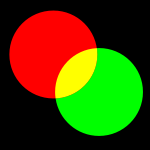
RG color space
The RG or red-green color space is a color space that uses only two colors, red and green. It is an additive format, similar to the RGB color model but without a blue channel. Thus, blue is said to be out of gamut. This format is not in use today, and was only used on two-color Technicolor and other early color processes for films; by comparison to a full spectrum, its poor color reproduction made it undesirable. The system cannot create white naturally, and many colors are distorted.
Any color containing a blue color component can't be replicated accurately in the RG color space. There is a similar color space called RGK which also has a black channel. Outside of a few low-cost high-volume applications, such as packaging and labelling, RG and RGK are no longer in use because devices providing larger gamuts such as RGB and CMYK are in widespread use. Until recently, its primary use was in low-cost light-emitting diode displays, where red and green tended to be far more common than the still nascent blue LED technology, though full-color LEDs with blue have become more common in recent years.

Color space
A color space is a specific organization of colors. In combination with physical device profiling, it allows for reproducible representations of color, in both analog and digital representations. A color space may be arbitrary, with particular colors assigned to a set of physical color swatches and corresponding assigned names or numbers such as with the Pantone system, or structured mathematically, as with Adobe RGB or sRGB. A color model is an abstract mathematical model describing the way colors can be represented as tuples of numbers (e.g. triples in RGB or quadruples in CMYK); however, a color model with no associated mapping function to an absolute color space is a more or less arbitrary color system with no connection to any globally understood system of color interpretation. Adding a specific mapping function between a color model and a reference color space establishes within the reference color space a definite "footprint", known as a gamut, and for a given color model this defines a color space. For example, Adobe RGB and sRGB are two different absolute color spaces, both based on the RGB color model. When defining a color space, the usual reference standard is the CIELAB or CIEXYZ color spaces, which were specifically designed to encompass all colors the average human can see.
Podcasts:

